Dietrich Grunewald
Dietrich Hermann Grunewald aka Dietrich (December 22, 1916 – May 21, 2003) was an American artist and designer, whose prolific and diverse works encompassed oils on canvas, oils on paper, serigraphs, commercial illustrations, portraits, etchings, drawings, and scenic, textile, and wallpaper designs.[1][2]
Dietrich Grunewald | |
|---|---|
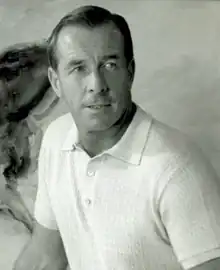 Dietrich Grunewald, ca.1967 | |
| Born | December 22, 1916 |
| Died | May 21, 2003 La Quinta, CA, U.S. |
| Other names | Dietrich |
| Occupations |
|
| Years active | 1935–1998 |
| Known for |
|
| Notable work |
|
Early life
Dietrich Hermann Grunewald was born in Oskarström, Sweden, to parents of German ancestry. His father, Eduard Gottfried Grunewald (1873-1943), was born in Nicaragua to a German Moravian missionary and his wife, while his mother, Elisabeth Feldmann (1882-1975), was born in London to a German salesman and cigar manufacturer and his wife.[3]
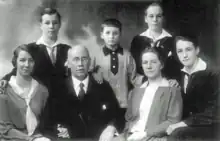
Elisabeth Feldmann studied voice and piano at the Dresden Conservatory, before deciding to become a nurse. However, her training was cut short when she had to return home to attend to family matters. Eduard Grunewald was trained in bookbinding and textile engineering, and moved to Oskarström in 1907 to work as an engineer at a textile factory. He met Elisabeth after traveling to Hernhutt, Germany, to “find himself a bride.”[4] After a brief courtship, the couple married in 1911 and subsequently raised their family in Oskarström. In 1929, Eduard retired to become a Moravian missionary and the family moved to Helsingborg. Over the course of the next 10 years, his missionary work entailed travel to the United States, Mexico, Canada and other countries, while Elisabeth stayed at home to raise their children.

Dietrich's artistic training emanated from a variety of informal and formal activities. At an early age, he was said to be captivated by the foreboding nature of the pine forest behind his home, with its vast and mysterious understory. These tangible elements stimulated his curiosity and imagination prompting him to study the forest's plant life. From there, an early interest in figurative drawing led him to explore anatomy, bolstered by books his father had given him containing drawings of the Old Masters which he would copy in order to become more fluid in his free hand drawing. Between 1933 and 1935, he enrolled in commercial art classes at Welamson's Art School in Stockholm, which led to his first professional job at Herson's Agency, an advertising firm that had just opened in the city. Between 1935 and 1937, he created concepts for ad campaigns and produced renderings of the finished artwork for Herson's, while also working freelance as an illustrator for magazine publishers.[5]

After moving to Helsingborg with his family in 1929, he was stricken with polio and rheumatic fever within two years of moving there.[6] Even after overcoming these afflictions, a train accident at the age of 20 shattered his right knee, leaving him nearly incapacitated and questioning his future.[7] In the aftermath of his surgery, he recalled an ad he had seen in the back pages of the Saturday Evening Post for study at the American Academy of Art in Chicago and resolved to chart a new course by moving to America to pursue his childhood dream of becoming a fine artist.[8]
In February 1938, Dietrich arrived in the US and began attending classes at the American Academy of Art.[9] Although he had been persuaded by its director to study commercial art, not long after entering the program, he began skipping classes to immerse himself in the galleries of the Art Institute of Chicago. Before the semester had ended, he had decided to leave Chicago and head west in pursue a career as an artist.
Career
Scenic design and drafting

After leaving Chicago, Dietrich initially settled in downtown Los Angeles, where he enrolled in classes to study anatomical drawing at night and poured over art books housed at the Los Angeles Public Library during the day. Also during this time, he began producing a series of etchings documenting the city's street life. In 1938, he met a Danish conductor named Charles Lautrup who invited him to design the sets for a one-night production he was to be conducting of the Danish national music-drama, “Elverhøj” (aka “The Elves’ Hill”), as part of the 1939 Golden Gate International Exposition. Dietrich accepted Lautrup's offer and soon found himself relocating to San Francisco, where he began research, producing concept and final drawings, and working with a team to create the backdrops.[10]
“Elverhøj” was performed at the War Memorial Opera House on June 18, 1939.[11] On the night of the performance, he met heldentenor, Lauritz Melchior, and veteran character actor, Jean Hersholt, both of whom urged him to explore production work in Hollywood.[12] In the months following the performance, he stayed in San Francisco and resumed a course of independent art study by regular visits to the library, taking night classes in etching and drypoint, and capturing the Bay Area’s urban, rural and waterfront scenery through paintings, drawings and etchings, which were exhibited at the Courvoisier Galleries in San Francisco.[13]
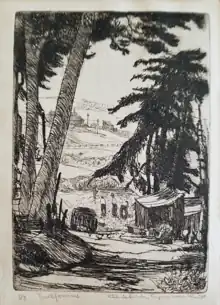
In 1940, he returned to Los Angeles and was hired for production work at 20th Century-Fox Studios, where he was tasked with projecting dimensional drawings from architectural blueprints to facilitate set construction, along with continuity sketches. His initial assignments consisted of two Carmen Miranda musicals, Down Argentine Way and Springtime in the Rockies. His next assignment was at Paramount Pictures where he worked under the supervision of acclaimed production designer William Cameron Menzies to create the storyboards for For Whom the Bell Tolls.[14]

Following America's entry into World War II, Kaiser Shipyards in Vancouver, Washington, contacted him about applying his drafting skills to aid in war production. Similar to what he had done at 20th Century-Fox, he was tasked with creating axonometric drawings from architectural blueprints to aid in ship construction. In late spring 1942, he moved to Portland, Oregon, where he commuted every day to the Kaiser Shipyards in Vancouver. By winter, he had received an offer to transfer to the shipyards in Richmond, enabling him to return to the Bay Area. As a Swedish citizen, Dietrich had initially come to the US on a student visa and had looked into the possibility of applying for American citizenship. However, once the US entered the war, his becoming a citizen was contingent upon his going to war, which he refused to do. Alternately, he was advised by the Swedish Consulate that he could obtain an exemption based on his Swedish citizenship, and re-apply after the war ended. However, as he learned at the war's conclusion, it would not be possible to do so until many years to come, when he finally became an American citizen at the age of 80.[15]
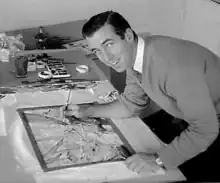
In 1944, he was hired by Samuel Goldwyn Productions in Hollywood to create the storyboards for the Danny Kaye musical Up in Arms, and the Bob Hope comedy The Princess and the Pirate. This in turn led to an assignment at Walt Disney Productions, where he created the matte drawings for the live-action background sequences of Song of the South.[16]
Textiles and wallpapers
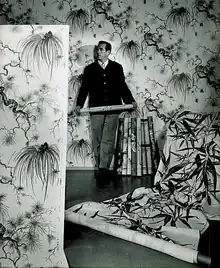
A studio-wide strike between 1945 and 1946 compelled Dietrich to venture beyond the art departments of Hollywood and explore new ways of making a living. Heeding the suggestion of costume designer, Edith Head, he contacted San Francisco-based textile designer and weaver, Dorothy Liebes, about the prospect of branching out into wallpaper and textile design. In addition to her success as a designer and weaver, Liebes was also a savvy businesswoman. After reviewing his sketches and color samples, she invited him to showcase his work that fall to her East Coast buyers at New York City's Gotham Hotel. For the next two months, he worked on developing a design portfolio for the showcase, which Liebes would later brand “The New California Look.” The success of this showcase enabled him to forge a new path in textile and wallpaper design, securing contracts with leading U.S. manufacturers, such as Scalamandré Silks, Schumacher & Co., Kent-Bragaline, Katzenbach and Warren, and Morley-Fletcher.[17] Some of his more popular designs for textiles and wallpapers included Asian-inspired motives of cherry, pine and ming trees, Southwestern pueblos, Over-sized oak leaves printed on Peruvian linen and scenes of Americana.[18] In particular, Dietrich's oak leaf design on Peruvian linen received national attention through exhibitions at the Metropolitan Museum of Art, Museum of Modern Art and the Art Institute of Chicago, among others.[19] Upon his return from New York, he rented a storefront on West 3rd Street in West Hollywood, where he worked as a freelance designer until opening Dietrich Studios in 1948.[20] By the late 1950s, Dietrich's textile and wallpaper designs could be found on the walls, windows and furniture of various U.S. Embassies; President Truman’s “Little White House” in Key West, Florida; the Governor's Palace in Manila; the S.S. United States; and an array of popular hotels, such as the Ambassador, Beverly Hills, Oceanhouse, Tropicana, Flamingo and St. Francis.[21]
Serigraphs

Dietrich's introduction to serigraphs started at Dietrich Studios, where he began experimenting with design and production. Soon, he was producing pairs and trios of prints unified by theme and palette that he marketed as “decorative paintings” to complement his wallpaper and textile designs. In 1949, he met a German framer named Werner Rodman, who sought to capitalize on Dietrich's artistry through a collaborative venture. In the mid-1950s, Rodman proposed a plan whereby the artist would create the designs for serigraphs and monitor production of them, while Rodman, operating under the auspices of the Van Amstel Company, would produce, market and distribute them. Over the next 25 years, Dietrich made regular visits to Van Amstel's Culver City factory, where he supervised production of his limited-edition serigraphs, which were then sold through department stores across the country, such as Broadway, Bullock's, Gimbels, Macy's, Marshall Field & Co. and others.[22] Dietrich's association with Rodman and Van Amstel proved to be a successful partnership that provided him with the financial grounding to pursue his lifelong ambition to become a fine artist.
Paintings
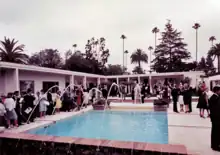
By the mid-1950s, Dietrich's goal of becoming a fine artist had been overshadowed by the constant demand to produce textile, wallpaper and serigraph designs. Frustrated by a lack of progress, he resolved to rededicate himself to his childhood dream through independent study and experimentation. In 1959, he acquired a studio residence in the Los Angeles suburb of Pacific Palisades, and in 1961, he was commissioned to paint a large-scale mural for the new Union Federal Bank headquarters in downtown Los Angeles.[23] This was followed by another mural commission for the Prudential Life Insurance Company.
Two years later, he partnered with real estate scion, developer and interior designer, William Tishman, to present an exhibition of his impressionist works at a house Tishman had built on spec in Beverly Hills.[24] The event, billed as “The Vernissage of ‘Dietrich’”, attracted over 2,000 people on its opening weekend in June 1963, including decorators, interior designers, architects, art collectors, society people and celebrities, and the general public. The vernissage marked his formal introduction into Southern California's art colony, and was a prelude to a host of exhibitions throughout California and in various cities across America, as well as in galleries in Sydney, Toronto, El Salvador, Hong Kong and Stockholm.[25] In 1993, he moved to La Quinta, California, where he continued to show and paint until the late 1990s.
Style and technique
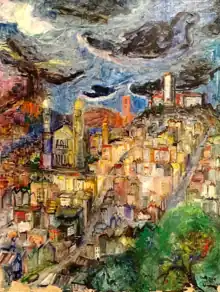
A study of Dietrich's early paintings from the late 1930s and early 1940s reflects his attraction to Van Gogh's bold use of color and the impasto technique, characterized by thick layers of paint showing the texture of brush strokes or a palette knife. Color would continue to play a significant role in his work and he also cited the influence of Pierre Bonnard for his “nuanced color arrangements” and Henri Matisse for his “original use of color, an intuitive control of space and innovative sense of spatial exploration”.[26]

Dietrich was also influenced by the works of Caravaggio, Murillo and Rembrandt, whose strength lay in their ability to master light and emphasize the enigmatic qualities of shadow, or chiaroscuro. He began experimenting with this technique by scouring and glazing the dark colors to extract the light from the canvas. He also cited the figures and landscapes of Leonardo, Michelangelo, Raphael and Dürer as being fundamental to his exploration and treatment of this subject matter.[27]
Beyond the Old Masters and early Modernists, two experiences left a deep impression on him: one, when as a child sitting in his mother's lap, he looked out the window and witnessed the early morning sky flaring up in a brilliant cascade of light, and the other, when he arrived in the Central California Valley as a young man and was bedazzled by a field of flowers. He noted that his fascination with light and color, long preserved in his dreams, emerged in a binding theme and permeated his creative endeavors. Seeking to translate these wonders of nature to his oils on canvas, he discovered that spatial depth could only be attained through the luminosity of the color and the graduation of light, achieved by a wet-on-wet technique that prevented any individual pigment from dominating the composition.
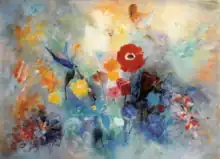
Dietrich would often employ fantasy imagery within a variety of natural settings as a way of breathing life into his work. Describing these flora fantasies as “leaps of imagination”, his imagery took the form of solitary nudes, lovers, musicians, sprites, animals, or any combination thereof set within idyllic settings that included flowerscapes, fields, meadows or forests.[28]

In some instances, he worked from photos provided by his patrons to incorporate the faces of their children into these settings. In the realm of figural representation, he took inspiration from Käthe Kollwitz for her transcendent works reflecting human passion and Grandma Moses for her ability to convey the purity of childlike innocence.[29]
Dietrich's study of human anatomy found its ultimate expression in a series of quasi-life-size sports paintings depicting football, baseball, soccer and tennis players, track-and-field athletes, and surfers.[30] He was also captivated by horses and the ways in which their physicality and movement could be expressed on the canvas, whether running wild, racing across a finish line or entangled in a polo match. Other subjects included children, lovers, matadors, mother and child tableaus, musicians, nudes, cityscapes, landscapes, townscapes, waterfronts and sailboats. Over the course of his fine art career, flora fantasies and horses would be recurring themes of his work.
 Serenade, oil on canvas, 33x24
Serenade, oil on canvas, 33x24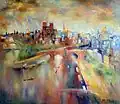 Seine View, Paris, oil on canvas, 36x42
Seine View, Paris, oil on canvas, 36x42 Waterfront scene, oil on paper, 26x40
Waterfront scene, oil on paper, 26x40 Skyview, San Francisco, oil on canvas, 26x31
Skyview, San Francisco, oil on canvas, 26x31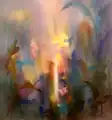 Tropical Fantasy, oil on canvas, 32x30
Tropical Fantasy, oil on canvas, 32x30 Enchanted Forest, oil on paper, 22x30
Enchanted Forest, oil on paper, 22x30 Billowing Sails, oil on canvas, 39x48
Billowing Sails, oil on canvas, 39x48 Desert Sunset, oil on canvas, 36x48
Desert Sunset, oil on canvas, 36x48 Day of the Hunt, oil on canvas, 36x57
Day of the Hunt, oil on canvas, 36x57 Goal Line Stand, oil on canvas, 78x42
Goal Line Stand, oil on canvas, 78x42 "The End of the Race", oil on canvas, 70x51
"The End of the Race", oil on canvas, 70x51
Personal life

Dietrich participated in sports both recreationally and competitively over the course of his lifetime, including soccer, tennis, skiing and body surfing. He was married four times and had five children by his first three marriages and two stepchildren by his third and fourth marriages. His first wife was Natalie Nicolaief Vally (1899-1988), a freelance photographer from Russia. They married in 1942 and had a daughter. His second wife was Mai-Britt Cedeby (1920-1980), a film and television script supervisor from Sweden. They married in 1950 and had two sons. His third wife was Reneé Gold Zutrau (1927-1976), a fashion designer, illustrator, costume supervisor, and artist from West Caldwell, New Jersey. She was a single mother with a son at the time they met. They married in 1959 and had two sons together.[31] His fourth wife was Patty Gilbert Hurst (1936- ), a loan processor from Beverly Hills, who was a single mother with a daughter at the time they met. They married in 1967 and had just celebrated their 36th wedding anniversary the day before he died in 2003.[32]
Exhibitions and gallery representation
Key:
E = exhibitions G = gallery representation[33][34][35]
| Year | Location | Exhibition Type |
|---|---|---|
| 1939 | Courvoisier Galleries, San Francisco | E |
| 1939 | Daniel Koshland Residence, San Francisco, California | E |
| 1946-1955 | Modern Museum of Art, NY | E |
| 1946-1955 | New York, NY | E |
| 1946-1955 | Art Institute of Chicago, IL | E |
| 1956-1963 | Various U.S. cities | E |
| 1956-1963 | Sydney, Australia | E |
| 1956-1963 | Toronto, Canada | E |
| 1956-1993 | Monteverdi-Young showroom, Los Angeles/West Hollywood, CA (G) | G |
| 1959-1993 | Dietrich studio residence, Pacific Palisades, CA (showings by appointment) | E |
| 1963 | Blue Lagoon Villas, Laguna Beach, Beverly hills,CA | E |
| 1963 | Gregg Juarez Gallery, Nice, France | E/G |
| 1964 | Blue Lagoon Villas, Laguna Beach, CA | E |
| 1964 | Ted Phillips residence, Huntington Harbor, CA | E |
| 1965 | Gregg Juarez Galleries, Los Angeles, CA and Palm Beach, FL | E/G |
| 1966 | Axel Danielson residence, Los Angeles, CA | E |
| 1969-1975 | San Francisco, CA | G |
| 1969-1975 | Minneapolis, MN | G |
| 1970-1980 | DeVeaux Gallery, Carmel, | G |
| 1974 | Dietrich studio residence, Pacific Palisades, CA | E |
| 1975 | Alexis Art Gallery, San Salvador, El Salvador | E |
| 1976 | Dietrich studio residence, Pacific Palisades, CA | E |
| 1976 | Brand Library and Art Center, Glendale | E |
| 1977 | Zantman Art Galleries, Palm Desert and Carmel, CA | E/G |
| 1979 | Asia Gallery, Hong Kong | E |
| 1980 | La Cañada Flintridge, CA | E |
| 1980 | Descanso Gardens, La Cañada Flintridge, CA | E
- |
| 1981 | Zantman Art Galleries, Palm Desert and Carmel, CA | E/G |
| 1981 | Danica showroom, Beverly Hills, CA | E |
| 1983 | Sunbird Art Gallery, Los Altos, CA | E/G |
| 1983 | Lyon Art Gallery, San Francisco, CA | E/G |
| 1985 | Bengtsson Gallery, Stockholm, Sweden | E/G |
| 1986 | Zantman Art Galleries, Palm Desert, CA | E |
| 1986 | Tatum Gallery, Ft. Lauderdale, FL | E |
| 1987 | Tatum Gallery, Ft. Lauderdale, FL | E/G |
| 1987 | Sunbird Gallery, Los Altos, CA ( | E/G |
| 1987 | Zantman Art Galleries, Carmel, CA | E/G |
| 1988 | American Embassy, El Salvador, San Salvador | E |
| 1989 | Dietrich residence, Pacific Palisades,CA | E |
| 1989 | Zantman Art Galleries, Palm Desert, CA | E/G |
| 1989 | Park Shore Gallery, Naples, FL | E/G |
| 1989 | Laguna Niguel, CA | E |
| 1989 | Margaret Sjodin residence, Malibu, CA | E |
| 1990 | Tokyo, Japan | E |
| 1990 | Berlin, Germany | E |
| 1990 | Bengtsson Gallery, Stockholm, Sweden | E |
| 1993 | Zantman Art Galleries, Palm Desert, CA | E/G |
| 1993-2003 | Dietrich residence, LaQuinta, CA | (showings by appointment) |
Notes and references
- "W.H. Dietrich". legacy.com. Los Angeles Times.
- Dalbeck Hagström, ed. (1953). Svenskt Konstnärs Lexikon (Swedish Artists Directory). Vol. II. Malmö: Allhems Förlag. pp. 319–320.
- "Dietrich Hermann Grünewald". geni_family_tree. 22 December 1916. Retrieved 2022-12-24.
- Dietrich Grunewald, Dietrich: Memoirs of My Life and Art (La Quinta, CA: UNPUBLISHED, 1997), 6.
- Koslowski, Jutta (April 2020). "Details from the Life of the Bonhoeffer Family: New Insights about the Biography and Theology of Dietrich Bonhoeffer in the Memoirs of his Youngest Sister Susanne". Theology Today. 77 (1): 9–32. doi:10.1177/0040573620916732. ISSN 0040-5736. S2CID 216336846.
- Juliet P. Schoen, "Dietrich Touch Can Change Dark to Light", Palisadian-Post, Family, October 23, 1981, 13.
- Schoen, 13.
- Schoen, 13.
- Leonard Clairmont, “Dietrich,” The American Swedish Monthly 45, no. 3 (March 1951): 16.
- Clairmont, 16-17.
- “In Danish: Drama Wins Applause,” The San Francisco Chronicle, June 19, 1939, 3.
- Clairmont, 17.
- Svenskt Konstnärs Lexikon, 320.
- Clairmont, 17.
- Yvette Cabrera, "Enlisting in America's Ranks; 10,000 Take Oath in Lagging Year", Los Angeles Daily News, October 17, 1997, N3.
- Clairmont, 17.
- Clairmont, 27.
- Dietrich's work as a textile and wallpaper designer was covered extensively by The New York Times between 1947 and 1951, where he was alternately referred to as "Dietrich", "Dietrich of California" and "William Dietrich" (aka "Bill Dietrich", a first name that he adopted in the early 1950s). Select New York Times articles include: Mary Roche, "New Ideas and Inventions", June 8, 1947, SM38; "Muted Colors Inspired by Earth and Plants Characterize Collection of New Wallpapers", August 1, 1947, 14; Mary Roche, "New Weaves Made in Drapery Fabric", September 15. 1947, 14; "Designer Provides 'Outdoors' in Home: 'Landscape' Colors Are Used by Dietrich in Home for Wallpaper and Matching Fabrics", June 26, 1950, 17; and "Drapery Fabrics Stress Unusual", August 21, 1951, 23.
- Clairmont, 27
- Svenskt Konstnärs Lexikon, 320; Examples of Dietrich Studios' wallpaper design can be found at the Cooper Hewitt at: Dietrich Studios, accessed September 26, 2022.
- Clairmont, 27.
- Schoen, 13.
- Schoen, 17.
- Schoen, 17.
- Schoen, 17.
- Grunewald, 84.
- Grunewald, 81.
- Grunewald, 83.
- Grunewald, 84.
- Alan Drooz, "Near Life-Size Tableaus: Artist Captures Sports Drama on Canvas", Los Angeles Times, January 29, 1981, SB2 (South Bay Edition) and February 1, 1981, WS11 (West Side Edition).
- Ancestry.com. California, U.S., Marriage Index, 1949-1959 [database on-line]. Provo, UT, USA: Ancestry.com Operations, Inc., 2013.
- "Obituaries: Dietrich Grunewald", The Desert Sun, May 27, 2003, B2
- This list was compiled from, and cross-referenced with, lists created by Dietrich Grunewald, exhibition brochures and newspaper articles, all on file with the Dietrich Family Estate, New York
- Koslowski, Jutta (April 2020). "Details from the Life of the Bonhoeffer Family: New Insights about the Biography and Theology of Dietrich Bonhoeffer in the Memoirs of his Youngest Sister Susanne". Theology Today. 77 (1): 9–32. doi:10.1177/0040573620916732. ISSN 0040-5736. S2CID 216336846.
- "Berner's Auction Gallery". Invaluable.
Sources
- Castagno, John “Grunewald, Dietrich.” Artists’ Monograms and Indiscernible Signatures: An International Dictionary, 1800-1991. Metuchen, N.J. /London: The Scarecrow Press, Inc., 1991.
- Dietrich Studios
- “Grunewald, Dietrich.” European Artists Signatures and Monograms, 1800-1991. Metuchen, N.J./London: The Scarecrow Press, Inc., 1990.
- Kienholz, Lyn, ed. (Elizabeta Betinski and Corinne Nelson, contributing eds.) “Dietrich.” L.A. Rising: SoCal Artists Before 1980. Los Angeles: The California/International Arts Foundation, 2010.
- Vollmer, H. (K.G. Saur, ed.) “Grunewald, Dietrich.” Allgemeines Künstlerlexikon (The Artists of the World). Vol. 4. München/ Leipzig: K.G. Saur, 2000.
External links
 Media related to Dietrich Herman Grunewald at Wikimedia Commons
Media related to Dietrich Herman Grunewald at Wikimedia Commons